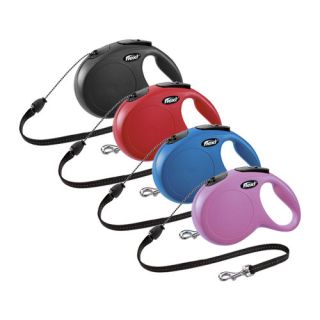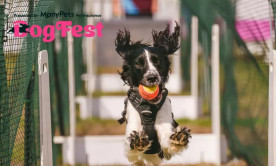Retractable dog leashes are designed to give your dog a sense of freedom while still giving owners control. When used responsibly they are perfectly safe, but when used in the wrong locations or used with poorly trained dogs by inexperienced owners they can be a serious hazard.
In this guide we go over why extending and retracting leads can be used completely safely, but also why some dog owners think they are dangerous and irresponsible.
Why do some dog owners think retractable leads are bad?
Like any piece of canine equipment, if you use a retractable lead incorrectly it can be hazardous to others and potentially harmful for the dog. If an owner is not paying attention their dog can run amuck and trip people up and get tangled around objects. This is especially true for extra long extending leads which can be up to 10 metres in length.
One of the most problematic aspects of extending leads is that the dog doesn’t act as if they’re on a leash at all. This poor leash discipline can be dangerous in a number of ways. Injuries can occur if the dog sprints ahead and the owner presses the lock-break in a panic, causing the dog to quickly jerk back. This can choke the dog and damage to the wind pipe and spine.
The negatives associated with extending dog leads come down to inexperienced owners and poorly trained dogs.
How to use retractable dog leads safely and responsibly
Owning a dog is a responsibility. This is even truer when taking the dog out in public and using specialised equipment like an extendable lead. Steps should be undertaken to ensure you are using these leads safely.
Step 1: Your dog must be leash trained
If your dog is not used to being on a lead or continuously pulls on the lead, then this lack of training is amplified on a retractable lead. The sooner your dog learns good leash discipline the better. We have two quick guides to lead training dogs:
Step 2: Additional behavioural training
Extending leads give your dog more freedoms to explore. Therefore it’s vital they also know basic commands like ‘heel’, ‘stop’, and ‘leave it’. This will help protect your dog from rummaging where they shouldn’t and avoid other dogs and people when needed.
Step 3: Your dog should be comfortable around others
Giving your dog a little extra freedom on an extending lead means they are should be comfortable around other dogs and people. If they’re not and come across other dog walkers they can become spooked. This is a recipe for problems if they are on a long extended leash. Therefore it’s important your dog remains calm around strangers.
See our Introducing Your Dog To Other Dogs & New People article for more information.
Step 4: Understanding how your retractable lead works
The leash of a retractable lead is contained in the handle. It rolls out when the dog pulls on the lead, allowing the leash to extend until it reaches its maximum length or you apply the break. As soon as the break is applied the leash immediately stops extending.
However, the lead won’t run back into the handle unless there is slack. This is an important safety feature that stops owners from reeling back their dog, which can be harmful. When the dog is on lead, the only way to shorten a taut leash is to catch up with your dog or call them back to you.
Step 5: Controlling the leash slack
Owners should only extend a retractable lead as much as necessary. Allowing the leash to extend too long will create too much slack – which means there will be a lot of leash out of your control.
Retractable leads allow your dog to explore areas safely and under your control. Letting dog’s sprint away from you and extending the lead too much takes away this control. It also can be very dangerous to let a dog sprint while on a retractable lead, as if you need to hit the break this will cause them to jerk backwards which can cause harm to their throat or spine.
it’s vital that a dog is leash trained and owners understand how much to extend the leash at any one time.
Step 6: Safe environments
Retractable leads are not a substitute of letting your dog off leash. Letting your dog run free is an important form of exercise and freedom but should only be done in a safe, open, and quite environment where they can’t cause harm to themselves or others.
Using an extendable lead provides an element of roaming freedom for your dog while keeping you in control.
When not to use retractable leads:
- When you need your dog at your heel, such as in shops or on pavements.
- In crowded, busy, public spaces.
- Around other dogs.
Step 7: Practice
You should be comfortable using your retractable lead before using out in public. Get used to using the break feature and how to reduce the slack of the leash in a safe space in home or garden.
What retractable leads to buy
Flexi dog leads are one of the most popular retractable dog leads in the world thanks to their safety record and reliability. Here at JULIUS-K9® UK we only stock dog equipment that we trust and sell two extendable leads form the Flexi range:
- Flexi Classic which extends to up to 5 metres
- Flexi Giant which can extend up to 8 or 10 metres depending on the model
Shop our entire range of retractable dog leads here.







